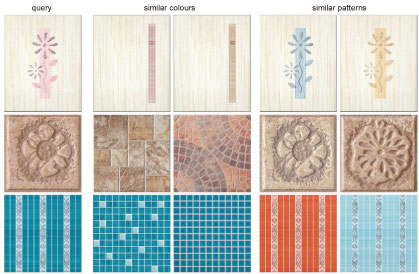Recent advances in illumination invariance and textural features were utilized in the construction of a content-based tile retrieval system, which eases laborious browsing of large tile catalogues. Regardless of whether a user is choosing tiles for their house or designing a prestigious office building, this computer-aided consulting system will help to select the right tiles by suggesting tiles which have similar colours and / or patterns as some other tiles that the user likes. The performance of the system was verified on a large commercial tile database in a psycho-physical experiment.
The tile retrieval system is based on an image representation by an underlying multi-spectral Markov random field. Spatial relationships within the image are modelled by a special type of Markov model, which allows efficient and analytical estimation of its parameters, avoiding the usual time-consuming Monte-Carlo approach. Tile patterns are represented by estimated model parameters, which are transformed into our illumination invariant textural features. These features are unaffected by illumination colour and robust to illumination direction variations, therefore arbitrary illuminated tiles do not negatively influence the retrieval result. To allow separate retrieval of similar patterns and / or colours, the system utilizes colour representation by marginal cumulative histograms.
The utilized features (colour invariants) are capable of representing colour patterns with same luminance and still remain robust to illumination colour, which is in contrast with a usual texture representation by gray-value textural features. The performance of our colour invariants was successfully verified using MUSCLE ERCIM working group cooperation utilizing the Amsterdam Library of Textures (ALOT), which contains images of over two hundred natural and artificial materials acquired in variable conditions.

Figure 1: The system offers catalogue tiles, which have similar colours or patterns (characteristics) as the query tile. The images are courtesy of Sanita.cz.
The tile retrieval system was verified in a visual psycho-physical experiment on a large commercial tile database containing several thousand images. In the experiment, the retrieved tiles were blindly ranked by volunteers as: very similar, similar, less similar, and dissimilar. In summary, 76% of retrieved images were considered to be very similar or similar, while only 12% were marked as dissimilar.
The system can be used in the following ways: A user can take a photo of old tile lining and find a suitable replacement for broken tiles from recent production. During browsing of digital tile catalogues, the system can offer tiles with similar colours or patterns as the selected tile, which could be integrated into an internet tile shop. Alternatively, the tiles can be clustered according to visual similarity and consequently, digital catalogues can be browsed hierarchically through the representatives of visually similar groups. In all cases, the system benefits from its robustness to illumination changes and possible noise degradation.
The presented retrieval system is not limited to tile images and it can be used with other kinds of image, where the visual structure and colour are important properties. Thus other possible applications in the home decor industry include retrieval of similar textiles / cloths and wallpapers. An interactive demonstration is available online.
Link: http://cbir.utia.cas.cz/tiles/
Please contact:
Pavel Vácha
CRCIM (UTIA), Czech Republic
Tel: +420 2 6605 2365
E-mail:










